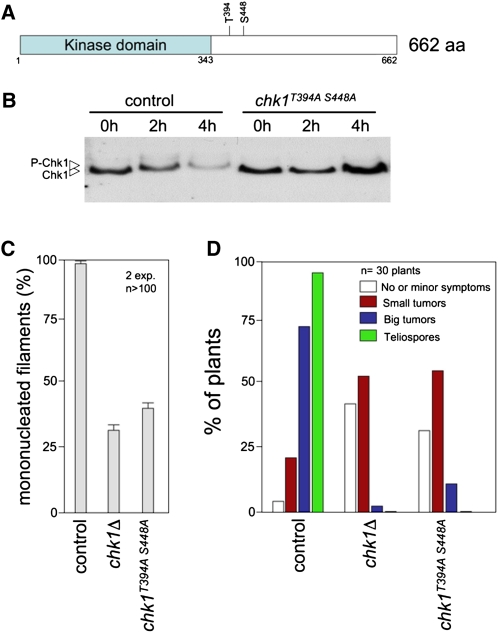Figure 1.
A chk1 Allele Refractory to Phosphorylation Mimics the chk1Δ Loss-of-Function Mutation with Respect to b-Dependent Filament Cell Cycle Arrest and in Planta Proliferation.
(A) Scheme of Chk1 showing the kinase domain and two phosphorylatable residues required for Chk1 activation. aa, amino acids.
(B) In vivo phosphorylation of Chk1 during b-dependent filamentation. AB33-derived cells carrying an endogenous chk1-T7 (control, UCS31) or the chk1T394A S448A allele (UMP183) were incubated in inducing conditions (MM-NO3) for the indicated time (in hours). Protein extracts were immunoprecipitated with a commercial anti-T7 antibody, and immunoprecipitates were subjected to SDS-PAGE and immunoblotted with anti-T7 antibody.
(C) AB33 (control, UCS31) and derived strains lacking the chk1 gene (chk1Δ, UMP114) or carrying the chk1T394A S448A allele (UMP183) were incubated in inducing conditions (MM-NO3). Cells were stained with 4′,6-diamidino-2-phenylindole to detect nuclei. The percentage of cells producing mononucleated filaments (i.e., cell cycle arrested) after 24 h of incubation is shown graphically. The graph shows the result from two independent experiments, counting more than 100 cells each. Means and sds are shown.
(D) Quantification of symptoms in maize plants after 14 d after infection with wild-type (control, UCM350xUCM520), chk1Δ (UMP122xUMP129), or chk1T394A S448A (UMP190xUMP191) mutant crosses.

